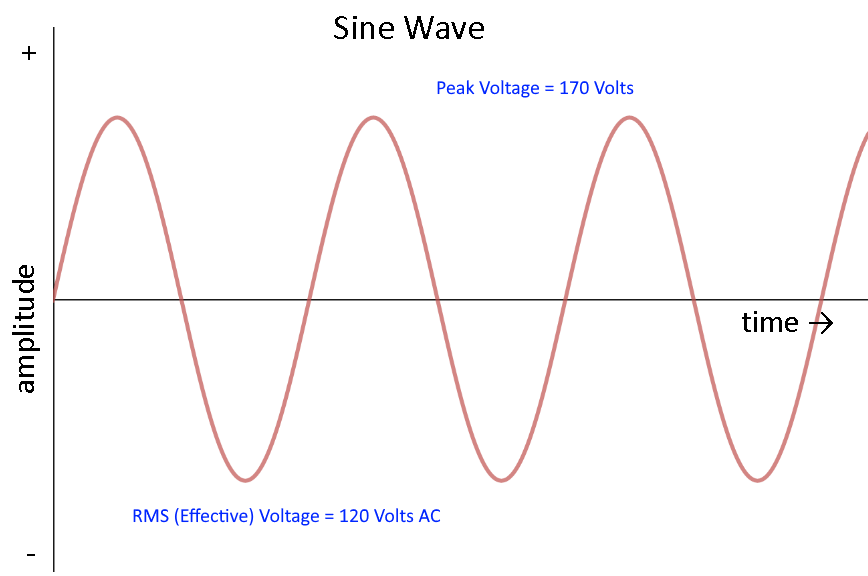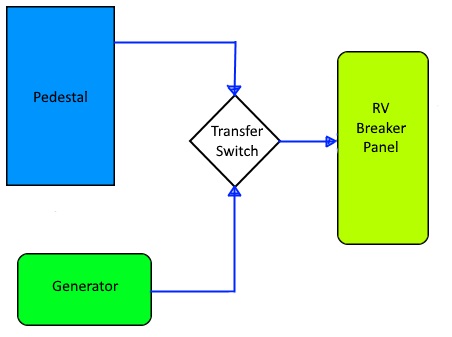RV Energy Management Systems
RVs of all types have two electrical systems: a 12 volt, automotive style DC power system and a residential style 120 volt AC power system. Understanding both of these systems is necessary to get the best use of your RV.
We will do a series to explain some of the intricacies of both systems and how they interact. This first segment is prompted by some recent discussions on surge protector for the AC portion of your RV. It’s necessary to go into some details on basic electrical systems to appreciate how to protect your RV and its appliances from electrical over loads.
The basic electrical system runs on alternating current, or AC, power. The voltage on the power lines is called a sine wave and looks like the picture below. The voltage follows the shape and constantly moves up to a peak and then down to a peak where the polarity of the voltage is reversed, and then back up to a positive peak in an endless wave of alternating positive and negative peaks.

The current waveform would look similar and alternates directions, going in one direction during the positive portion of the cycle and then reversing direction, or alternating direction, on the negative portion. That is what gives this type of power its name, alternating current.
Voltages in an AC system are normally given by the effective heating caused by the voltage and are called “RMS” (for Root Mean Squared) values. As you can see from the graph, the standard 120 VAC (volts alternating current) has a peak or maximum voltage of 170 volts.
In your sticks and bricks home, the outlets, lights, television and other appliances generally operate from 120 VAC. More power hungry devices like an electric range or electric dryer operate from 240 VAC. This happens because the power coming into your house has three wires: there are two wires that provide a total of 240 VAC (the “hot” wires) and a neutral voltage that sits half way between the two hot wires. If we use this as our reference point, then we would see 120 VAC on one side, and 120 VAC on the other side. The difference would be when one side was going up (towards +170 volts) the other side would be going down (towards -170 volts) so the two 120 VAC lines would add together to give you 240 VAC.
This is going to become important when we look at how AC power is used in and RV. If your RV has a 30 Amp service connection, then it gets a single hot line and a neutral, plus a safety ground and only gets 120 VAC from the pedestal.
If your RV has a 50 Amp service connection, then it gets two hot lines each of which can provide 50 Amps plus a neutral and a safety ground. If the pedestal is wired properly, then it will have the same 240 VAC power between the two hot leads. While you could have something in the RV that used the 240 VAC power, that is unusual except in some high end RVs and most RVs just hook things across one set of lead of the other. Because of the way RVs are wired, it is possible for the pedestal to have the same hot lead used for both connections to the outlet. While this is undesirable, and in violation of most electric codes, it is not unheard of. Also, some generators may provide separate leads to the two “sides” of the AC power cord, in fact they are in phase so that you would not see the 240 VAC if you hooked a voltmeter across the two hot leads, but 0 volts instead. This isn’t going to be a problem in most RVs but you should be aware of the possibility. The biggest problem if the pedestal is wired this way is that the neutral wire size has to be doubled to make sure it can handle all of the current.
Some RVs have internal electrical monitors that decide if you have a 30 Amp or 50 Amp connection based on whether or not you have 240 volts coming in on the service connection and may limit your power consumption based on this data. That is the topic for another discussion, however.
Why is all of this important? Because, if your power were all connected correctly, it wouldn’t be an issue, but in the real world pedestals are miswired, wires and connections can fail, and voltages from the pedestal might not be within an acceptable range for proper operation.
First let’s cover transients, or surges, on the power lines. Surges can occur for a number of reasons. For example, when a motor starts up it often needs a large surge of power to get the motor turning. This input surge can cause the 120 VAC line to drop, or sag, due to the large inrush current of the motor. This is negative surge and generally doesn’t have much effect on anything else because it is so short. There is also little that can be done about these surges except to make sure that all of the wiring is done properly and all connections are secure.
Surges where the voltage goes up significantly can happen for several reasons. Sometime when a heavy load (high current device) goes off line, it results in a surge where the line voltage jumps up. Depending on how high and how long the surge might be, most of the time it isn’t a problem, but if it is high enough and lasts long enough it can damage devices on the line, particularly electronic devices such as computers or microwave ovens.
Another type of surge is one caused by lightning strikes directly on a power line or nearby. These strikes can occur very close by with very high energy or a long way off but still coupled through the transmission lines to the pedestal you are plugged into and give you a short, but high, transient on the AC lines.
These types of surges are where “surge protectors” are useful. They contain devices internally that can absorb large amounts of energy for short periods of time. They basically operate as electric clamps on the line to limit the peak voltage on the lines. They will typically clamp the voltage at somewhere above 200 volts peak. This type of energy is measured in its value of Joules which is a measure of how high the voltage goes and how long it stays there. Surge protectors are rated in the number of Joules they can absorb so the higher the Joule rating, the better job the surge protector can do.
Here’s the thing with surge protectors: they can dissipate enough energy to protect from a lot of common surges, but they will not offer much protection from a direct lightning strike since the energy in a lightning strike is 10,000 or more times the rating of a practical surge protector.
The other thing is that surge protectors themselves are subject to what amounts to electrical wear. Each time they are energized they give up a small portion of their ability to absorb more energy. Given enough use they do wear out and lose their ability to work effectively.
But surge protectors only protect for a small part of what can go wrong with an electrical supply. Let’s look at some of the other problems that can occur,.
The voltage source is not within the allowed limits. Generally speaking, your appliances and electronic devices allow for some variation around the nominal 120 VAC. Each device may have its own specification but the standard requires that the service provide between 114and 126 VAC. It also provides that equipment operate between 104 and 127 VAC so there is some margin. Not every utility or manufacturer is going to adopt or adhere to these standards but they are good places to start to understand what is needed.
A device which provides only surge protection can do nothing to protect you from voltages that are outside the range of 104 to 127 VAC except for high voltage transients of short duration. This is where a more sophisticated device is needed. This device should certainly include a surge protector as part of its design, but needs to do more.
The first thing it needs to do is constantly monitor the incoming voltage to make sure it doesn’t go outside the expected range. It should have some built in timing function so that it will allow short term variations (such as caused when a motor goes on or off line and can cause a momentary condition which self corrects).
One of the most common situations that occurs is in a park where the wiring is less than adequate to provide 30 or 50 Amps to all of the pedestals connected on that line. In summer when lots of A/C is being used the demand for current on the line increases. The further away from the main electric service you are, the longer the line is going to be, and when more and more A/C units are coming on line the voltage drop along the line increases. If the wiring is not robust enough to handle this, your voltage will continue to drop. At some point, it may go below a value that is safe for the A/C motor to keep operating. You would rather the system shut off than continue to operate and burn out your A/C unit. It is annoying if this happens, but a good Energy Management System (EMS) will drop you off line and give you a fault code as to why it took that action.
While a higher sustained line voltage (above our desired voltage of 127 VAC) is less likely due to wiring or load issues, it can occur if there is a fault somewhere in the electrical system. In a 50 Amp connection, when the total voltage coming in is 240 VAC, a bad neutral connection can cause an imbalance in the system and one side can go up in voltage, while the other side sags in voltage. This can result in a simultaneous condition where one side is high and the other is low, but because of the complexity of the AC system, the imbalance does not have to be equal. So a bad neutral can cause a fault from too high voltage, too low voltage, or both conditions simultaneously.
A good EMS can provide protection from all of these various issues. Here’s how to hook one up:
First, let’s start with the pedestal itself.

We are going to assume that you also have an on board generator in your rig.

If you have both, then it is likely that you also have a transfer switch to control which source is in use.

The function of the transfer switch is to select one, and only one, of the sources of energy. In most systems, the switch is wired to give priority to the generator so if you have both connected, the generator is given priority and the switch will disconnect the pedestal if the generator is running.
Either of these sources can provide energy to the coach

Once the energy gets to the RV breaker panel, it is distributed throughout the RV by a series of breakers and associated circuit wiring.
At this point, you have to consider just how you want to install and use your EMS. If you want to use a portable unit, you would just plug the EMS into the pedestal and then your RV cord into the EMS system. However, unless your generator is selected by plugging your RV cord into a generator outlet socket, you would not have an option to use the EMS with your generator.
That is a common choice and sometimes the only practical way to use an EMS because it just isn’t feasible to wire the EMS into the RV. You do give up the ability of the EMS to make sure your generator isn’t acting up, unless you can also plug the RV into a generator outlet.
I chose to install the EMS inside the RV and it is wired this way.

By wiring it in this fashion, the EMS makes sure that the power is clean no matter the source. Here’s a photo of the actual installation.

Our unit is from Progressive Industries. They are a recognized manufacturer of Energy Management Systems, but not the only one. In no particular order, here are the manufacturers I was able to find with a Google search. There may be others out there as well.
Progressive Industries https://www.progressiveindustries.net/our-products
Southwire Surge Guard https://rvpower.southwire.com/products/surge-protection/
Camco http://www.camco.net/rv-electrical-protection/power-grip-voltage-protector-50amp-55306
Hughes Autoformers https://h ughesautoformers.com/power-watchdog-smart-surge-protectors/
What should you look for in an Energy Management System? Here is a list I compiled of the important parameters to consider in picking the best surge protector for yourself. Will every unit have every feature? Maybe not, but you will have to decide which is most important for you.
| RV Electrical Protections Features List |
| Electrical Ratings |
| Surge Suppression Level (in Joules) |
| UL Listed |
| Input Under/Over Frequency Detection |
| Input Under/Over Voltage Protection |
| Input Under/Over Frequency Protection |
| Input Open Neutral Protection |
| Input Open Ground Protection |
| Miswired Pedestal Protection |
| Weather Resistant (Portable Unit) |
| Source Diagnostic Display |
| Maximum Spike Current |
| Surge Failure Indicator |
| Time Delay on Power Up |
| Optional Remote Display |
| Field Serviceable |
| Warranty |
| Ease of Installation (Fixed Unit) |
The last point I will make is that, yes we have had a situation where the EMS became active and shut down our power. I will never know how many times the surge protection may have stopped some incoming transients from entering the RV because that is silent and no record is kept of such events. But we did have an issue in one park during the summer. The system would shut down our RV during hot afternoons.
By the time it was shut down, the display showed normal power, but the error code display showed that it had shut down due to low voltage on one side of the 50 Amp service. This was caused by bad wiring within the campground.
I was able to show this to the campground staff, and they allowed me to plug into the adjacent site which was unoccupied at the time so we were able to keep using the A/C. They had an electrician look at the system and he was able to identify a loose connection at the main service panel. He corrected that and the power was back to being OK.
Do I know for sure that the A/C would have been damaged? No, but that isn’t a test I want to run.
When you consider that the one A/C unit would have cost over $1000 to replace, the less than $300 I spend on the EMS had paid for itself more than 3 times over. You may never run into an issue where the EMS cuts your power to protect your RV, but consider how much it could cost if you had to replace multiple appliances in your RV and trade that against the cost of the unit.
plugin units don’t require any modifications to your unit and may be right for your circumstances. Installation of the permanently wired units is simple if you understand basic electric power wiring or you may need to have an electrician on RV mechanic do the installation for you, so that can add to the cost. Either way, you will have to decide what to do with the advice given here.
